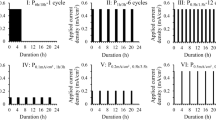Abstract
Purpose. Test to determine if iontophoresis and electroporation, alone or in combination, can be used for rapid and modulated delivery of fentanyl.
Methods. Fentanyl citrate (5 mg/ml) dissolved in pH 4.0 citrate buffer was delivered in vitro across human epidermis. For iontophoresis, a current of 0.5 mA/cm2 was applied for 5 h, using silver/silver chloride electrodes. Electroporation protocol consisted of applying 15 exponential pulses of 500V (applied voltage) and 200 msec duration at the rate of 1 pulse per minute at time zero and, in some cases, repeating at 1.5 and 2.5 h.
Results. There was no measurable permeation of fentanyl through human epidermis under passive conditions. A significant flux (about 80 μg/cm2-hr) was achieved using iontophoresis and decreased once the current was turned off. A 4-fold higher flux and shorter lag time was observed with electroporation as compared to iontophoresis. The flux was found to recover quickly (within 1 h) following pulsing. Modulation of transdermal delivery of fentanyl was demonstrated by both iontophoresis and electroporation.
Conclusions. Electrically assisted transdermal delivery of fentanyl significantly increased transport compared to passive delivery. Also, rapid and modulated delivery was shown to be feasible by programming the electrical parameters.
Similar content being viewed by others
REFERENCES
S. D. Roy and G. L. Flynn. Transdermal delivery of narcotic analgesics: pH, anatomic, and subject influences on cutaneous permeability of fentanyl and sufentanil. Pharm. Res. 7:842–847 (1990).
M. A. Simmonds. Transdermal fentanyl: Clinical development in the United States, Anti-Cancer. Drug 6:35–38 (1995).
R. Payne, S. Chandler, and M. Einhaus. Guidelines for the clinical use of transdermal fentanyl, Anti-Cancer. Drug 6:50–53 (1995).
B. Donner and M. Zenz. Transdermal fentanyl: A new step on the therapeutic ladder, Anti-Cancer. Drug 6:39–43 (1995).
M. A. Southam. Transdermal fentanyl therapy: System design, pharmacokinetics and efficacy, Anti-Cancer. Drug 6:29–34 (1995).
R. Miguel, J. M. Kreitzer, D. Reinhart, P. S. Sebel, J. Bowie, G. Freedman, and J. B. Eisenkraft. Postoperative pain control with a new transdermal fentanyl delivery system: A multicenter trial. Anesthesiology 83:470–477 (1995).
P. Fiset, C. Cohane, S. Browne, S. C. Brand, and S. L. Shafer. Biopharmaceutics of a new transdermal fentanyl device. Anesthesiology 83:459–469 (1995).
S. D. Roy, M. Gutierrez, G. L. Flynn, and G. W. Cleary. Controlled transdermal delivery of fentanyl: Characterizations of pressure-sensitive adhesives for matrix patch design. J. Pharm. Sci. 85:491–495 (1996).
S. Grond, L. Radbruch, and K. A. Lehmann. Clinical pharmacokinetics pharmacokinetics of transdermal opioids: focus on transdermal fentanyl. Clin. Pharmacokinet. 38:59–89 (2000).
W. Korte, N. deStoutz, and R. Morant. Day-to-day titration to initiate transdermal fentanyl in patients with cancer pain: Short-and long-term experiences in a prospective study of 39 patients. J. Pain Symptom Mgmt. 11:139–146 (1996).
S. Thysman and V. Preat. In vivo iontophoresis of fentanyl and sufentanil in rats: Pharmacokinetics and acute antinociceptive effects. Anesth. Analg. 77:61–66 (1993).
S. Thysman, C. Tasset, and V. Preat. Transdermal iontophoresis of fentanyl-Delivery and mechanistic analysis. Int. J. Pharm. 101:105–113 (1994).
M. A. Ashburn, J. Streisand, J. Zhang, G. Love, M. Rowin, S. Niu, J. K. Kievit, J. R. Kroep, and M. J. Mertens. The iontophoresis of fentanyl citrate in humans. Anesthesiology 82:1146–1153 (1995).
A. K. Banga. Electrically assisted transdermal and topical drug delivery, Taylor & Francis, London; 1998.
S. K. Gupta, M. Southam, G. Sathyan, and M. Klausner. Effect of current density on pharmacokinetics following continuous or intermittent input from a fentanyl electrotransport system. J. Pharm. Sci. 87:976–981 (1998).
S. K. Gupta, K. J. Bernstein, H. Noorduin, A. Van Peer, G. Sathyan, and R. Haak. Fentanyl delivery from an electrotransport system: delivery is a function of total current, not duration of current. J. Clin. Pharmacol. 38:951–958 (1998).
A. K. Banga and M. R. Prausnitz. Assessing the potential of skin electroporation for the delivery of protein-and gene-based drugs. Trends Biotechnol. 16:408–412 (1998).
M. J. Jaroszeski, R. Heller, and R. Gilbert. (Eds), Methods in Molecular Medicine: Electrochemotherapy, Electrogenetherapy, and Transdermal Drug Delivery-Electrically mediated delivery of molecules to cell, Humana Press, New Jersey, 2000.
R. Vanbever, E. LeBoulenge, and V. Preat. Transdermal delivery of fentanyl by electroporation.1. Influence of electrical factors. Pharm. Res. 13:559–565 (1996).
R. Vanbever, G. Langers, S. Montmayeur, and V. Preat. Transdermal delivery of fentanyl: rapid onset of analgesia using skin electroporation. J. Control. Release 50:225–235 (1998).
S. Chang, G. A. Hofmann, L. Zhang, L. J. Deftos, and A. K. Banga. The effect of electroporation on iontophoretic transdermal delivery of calcium regulating hormones. J. Control. Release 66:127–133 (2000).
J. Lambropoulos, G. A. Spanos, N. V. Lazaridis, T. S. Ingallinera, and V. K. Rodriguez. Development and validation of an HPLC assay for fentanyl and related substances in fentanyl citrate injection, USP. J. Pharm. Biomed. Anal. 20:705–716 (1999).
U. Pliquett, E. A. Gift, and J. C. Weaver. Determination of the electric field and anomalous heating caused by exponential pulses with aluminum electrodes in electroporation experiments. Bioelectrochem. Bioenerg. 39:39–53 (1996).
D. Miklavcic, K. Beravs, D. Semrov, M. Cemazar, F. Demsar, and G. Sersa. The importance of electric field distribution for effective in vivo electroporation of tissues. Biophys. J. 74:2152–2158 (1998).
R. Vanbever and V. Preat. In Vivo efficacy and safety of skin electroporation. Adv. Drug Deliv. Rev. 35:77–88 (1999).
M. S. Wallace, B. Ridgeway, E. Jun, G. Schulteis, D. Rabussay, and L. Zhang. Topical delivery of lidocaine in healthy volunteers by electroporation, electroincorporation, or iontophoresis: an evaluation of skin anesthesia. Reg Anesth. Pain Med. 26:229–238 (2001).
Author information
Authors and Affiliations
Corresponding author
Rights and permissions
About this article
Cite this article
Conjeevaram, R., Banga, A.K. & Zhang, L. Electrically Modulated Transdermal Delivery of Fentanyl. Pharm Res 19, 440–444 (2002). https://doi.org/10.1023/A:1015135426838
Issue Date:
DOI: https://doi.org/10.1023/A:1015135426838



